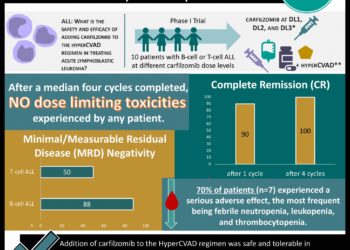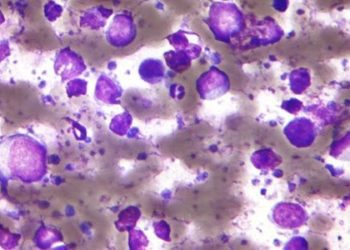Tag: acute lymphoblastic leukemia
KTE-X19 may induce remission in patients with relapsed or refractory B-cell lymphoblastic leukemia
1. 71% patients achieved complete remission or complete remission with incomplete recovery following KTE-X19 infusion. 2. The majority of adverse ...
Allogeneic anti-CD19 T cell therapy shows a manageable safety profile in pediatric and adult patients with high risk B-cell acute lymphoblastic leukemia
1. In two phase 1 studies, allogenic anti-CD19 CAR T cell (UCART19) treatment showed a manageable safety profile with relapsed ...
Acute lymphoblastic leukemia disease burden associated with safety and efficacy of CD19-CAR therapy
1. Patients with a higher disease burden of acute lymphoblastic leukemia (ALL) treated with CD19-specific chimeric antigen receptor (CAR) T ...
Rituximab improves survival in B-cell lineage acute lymphoblastic leukemia
1. Compared to standard chemotherapy alone, the addition of the rituximab significantly improves event-free survival among adults with CD20-positive, Philadelphia ...
Inotuzumab ozogamicin linked to better outcomes than standard chemotherapy for ALL: The INO-VATE ALL trial
1. Inotuzumab ozogamaxin (IO) demonstrated significantly higher complete remission rates and median progression-free survival compared to standard chemotherapy in relapsed ...
Risk factors for asparaginase-associated pancreatitis identified in patients with acute lymphoblastic leukemia
1. In a retrospective review of over 5000 children with acute lymphoblastic leukemia (ALL) who received asparaginase induction therapy, independent ...
2 Minute Medicine Rewind February 15, 2016
Longitudinal assessment of neurocognitive outcomes in survivors of childhood acute lymphoblastic leukemia treated on a contemporary chemotherapy protocol Acute lymphoblastic ...
Patient Basics: Acute Lymphocytic Leukemia (ALL) in Adults
Originally published by Harvard Health. What Is It? Acute lymphocytic leukemia (ALL) is a type of leukemia. Leukemia is a ...








